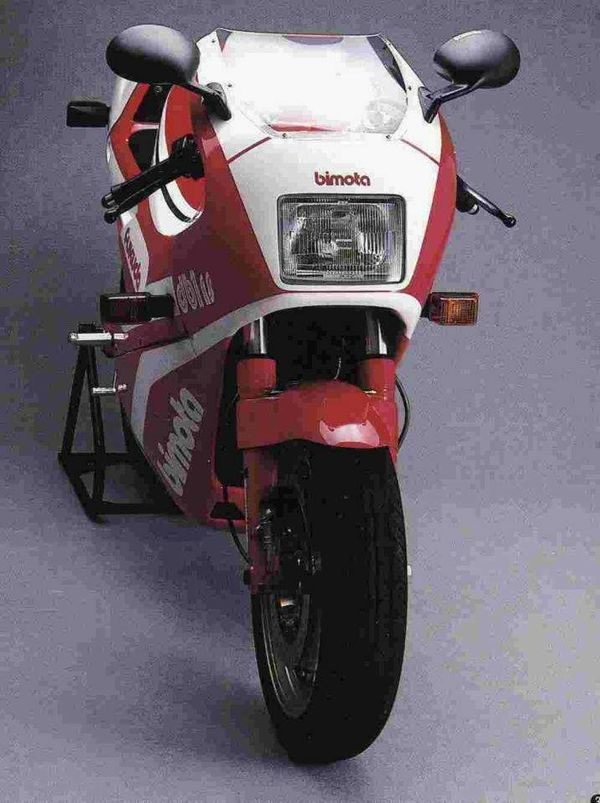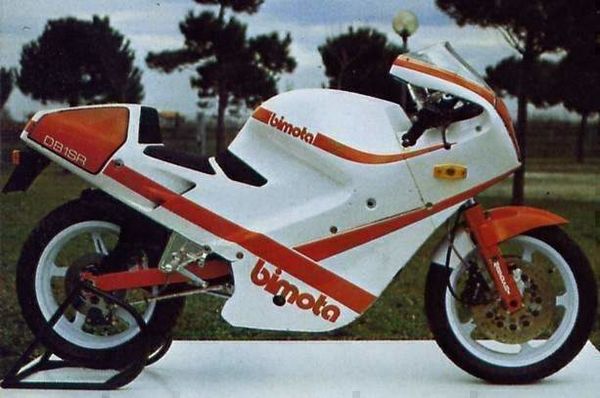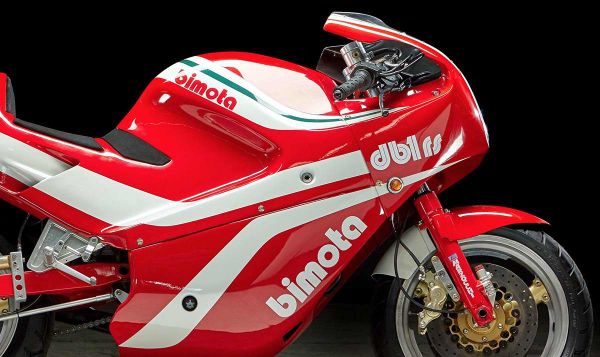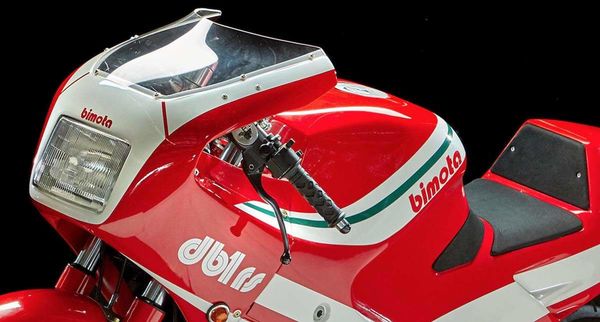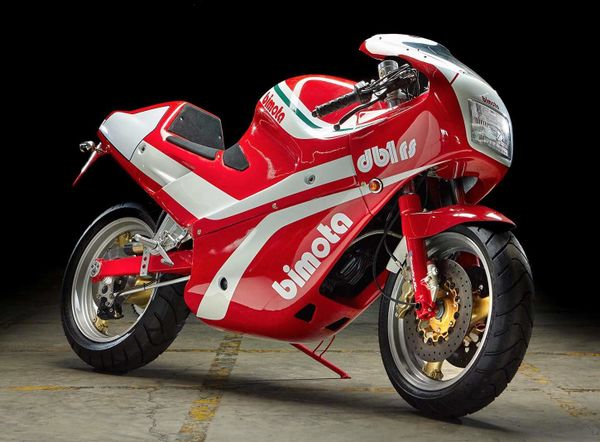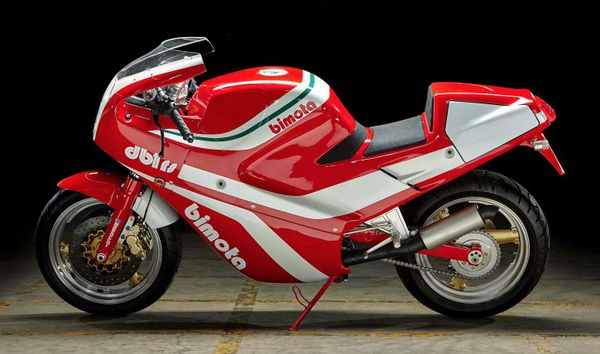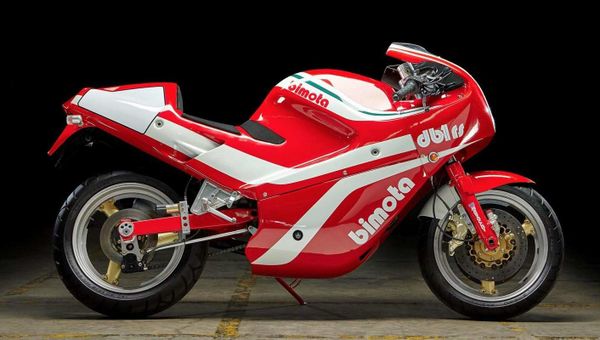Bimota DB1SR
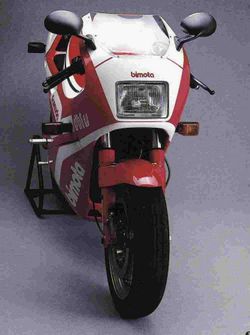 |
|
| Bimota DB1SR | |
| Manufacturer | |
|---|---|
| Production | 1987 (production 153) |
| Engine | Four stroke, 90°Ltwin cylinder, SOHC, desmodromic 2 valves per cylinder (Ducati 750 Pantah) |
| Compression ratio | 10.4:1 |
| Ignition | - |
| Transmission | 5 Speed |
| Frame | Load bearing space frame structure made of chrome-molybdenum steel |
| Suspension | Front: 41.7mm Telescopic M.1.R Marzocchi with 4-way rebound damping Rear: Rising rate linkage with Marzocchi shocks with adjustable preload 11 position compression damping |
| Brakes | Front: 2x 280mm discs 1 piston calipers Rear: Single 260mm disc |
| Front Tire | 130/80 V16 |
| Rear Tire | 160/80 V18 |
| Weight | 160 kg / 352.7 lbs (dry), |
| Fuel Capacity | 22 Liters / 5.8 US gal |
| Manuals | Service Manual |
Engine[edit | edit source]
The engine was a Air cooled Four stroke, 90°Ltwin cylinder, SOHC, desmodromic 2 valves per cylinder (Ducati 750 Pantah). The engine featured a 10.4:1 compression ratio.
Chassis[edit | edit source]
It came with a 130/80 V16 front tire and a 160/80 V18 rear tire. Stopping was achieved via 2x 280mm discs 1 piston calipers in the front and a Single 260mm disc in the rear. The front suspension was a 41.7mm Telescopic M.1.R Marzocchi with 4-way rebound damping while the rear was equipped with a Rising rate linkage with Marzocchi shocks with adjustable preload 11 position compression damping. The DB1SR was fitted with a 22 Liters / 5.8 US gal fuel tank. The bike weighed just 160 kg / 352.7 lbs.
Photos[edit | edit source]
Overview[edit | edit source]
Bimota DB1SR
A better Bimota: DB1SR. By Bruno de Prato, July 1987.In 1986 when Bimota engineers mated one of their chassis to a Ducati engine, they created a motorcycle, which became their best selling bike and boosted the companies' reputation by more than any of its previous machines. The DB1 changed Bimota from a small volume specialty house into a recognised manufacturer of prestigious, quality designed motorcycles.It all happened during Bimota's darkest hour, with former partners Massimo Tamburini and Guiseppe Morri fighting over the companies' fate in a Rimini court, and Bimota running out of financial breath. You're looking at the happy epilogue. Outwardly nearly identical to the standard DB1,
The DB1SR incorporates tuning changes that make it the motorcycle Bimota would have loved to have built first, the true Bimota, unfettered by bureaucratic compromise. Business sense prevailed against producing the SR - until now. To survive financially, Bimota needed to sell DB1's in the world market, and strict homologation in Switzerland, Holland and the United States - particularly noise laws - dictated the 750 cc Pantah F1 engine in the DB1 wear restrictive air cleaners and a civilized two into one exhaust. Historically, Ducati engines make their best power when they breathe freely, and the more muffler and airbox volume, the better. Yet Bimota's DB1's natural density meant that the airbox and mufflers had to shrink. The Rimini's companies' reputation is founded upon elegant, nimble machines, but nobody wants a stone. (Our test unit cantered through the quarter mile in 12.61 seconds at 104 mph, May 1986).
The DB1 needed more
punch, and with the SR Bimota took the direct Italian path. Forget the noise
- this Bimota is only for countries liberal enough to savor its sound. Dr,
Frederico Martini, a graduate of Ducati's research and development
department and the man who designed the DB1 frame, knew exactly where to
look for the missing power. Gone are the restrictive air filtration units
and the heavy twin exhausts, the skimpy 36mm carburetors are history too.
This 750 breathes through Malossi modified 41mm Dell'Ortos, complementing a
pair of Montjuich specification camshafts, Martini would have used the
excellent Ducati NCR two into one racing pipes, but these must be
excessively modified to fit the DB1 chassis. Martini experimented with
various exhaust systems on Bimota's DB1 race bike last year, and chose a
pipe for the SR, which quits the bike without strangling the engine. With
the larger carbs, Martini wanted the SR's ports cleaned up. For smooth
airflow, intake ports are machined to 34mm - the same diameter as the
carburetor throats downstream from their venturis. Martini's experience pays
off, the homologated European spec. SR engine produces (claimed figures) 82
horsepower at the crankshaft (about 75 at the rear wheel), an increase of 15
horses.
Top speed is 142 mph, quarter mile times in the low 11's, good for
any 750 and phenomenal for a twin. From aboard the SR, the exhaust note
sounds loud but low pitched, not fatiguing. But the intakes bark loudly up
through the fibreglass body shell, forecasting the bit this engine holds in
store. Surprisingly the bike will idle, though tunes as hot as it is the SR
burps and coughs below 3000 rpm. From 3000 rpm to 10,000 rpm the engine
pushes like a hydraulic ram, with no flat spots or dips. Torque does not
"come in" it is everywhere. A tachometer has never been so useful on an
Italian twin. The DB1SR is so smooth, so even in its power delivery that an
inattentive rider can easily over rev the engine. Our first test ride on the
DB1 last year, we said the chassis felt rigid enough to take another 20
horses gracefully. Here is proof. On the track the SR delivers a remarkable
riding experience, barely this side of pure road racing, even if you are
just out for a leisurely ride. On the road the Bimota's handling and power
means extra confidence and a broader safety margin. This is familiar praise
to anyone who has ridden a Bimota - for the SR we have another laurel to
add. Past Bimota's have often been too stiffly sprung for comfort on the
street, but the SR, as tight and racy that it is, negotiates bumpy surfaces
without beating its rider into an early submission. Only one point spoils the
symbiosis between rider and machine, the SR has an overly stiff clutch
lever. Ducati's punishing clutches are legendary, but this time it is not
the engine builder's fault - it has to do with the SR's brakes. The DB1 SR
uses a par of Brembo four piston calipers on its front disc. To actuate
these properly, a master cylinder with a round, remote reservoir mounted
atop the right fork leg.
This reservoir / master cylinder combination comes
with a 16mm bore only. Although the clutch requires a 13mm bore master
cylinder for perfect actuation feel - that is the size the Paso uses -
Bimota fitted the "16" cylinder on the left as well, for the sake of symmetry. Bimota plans to continue producing the stock DB1 for places with
noise restrictions and wealthy neighborhoods - the standard DB1 goes for
five bucks under $12,000. To that lofty figure add another $2500 and a full
throated exhaust note for the DB1 SR. Most of us will never own one of these
exotics, but Bimota wants only satisfied customers, and for people who
bought a DB1 last year and now think their bike is less than perfect, the
company offers an SR conversion kit. Until Ducati sees fit to send some four
valve, liquid cooled engines down Rimini way, the DB1 SR stands as the
closest incarnation of the true sporting Italian motorcycle.
Source
By Bruno de Prato, July 1987
| Make Model | Bimota DB1SR |
|---|---|
| Year | 1987 (production 153) |
| Engine Type | Four stroke, 90°Ltwin cylinder, SOHC, desmodromic 2 valves per cylinder (Ducati 750 Pantah) |
| Displacement | 748 cc / 45.6 cub in. |
| Bore X Stroke | 88 x 61.5 mm |
| Cooling System | Air |
| Compression | 10.4:1 |
| Induction | 2x 41mm Dell'Orto carbs |
| Ignition | |
| Starting | Electric |
| Max Power | 59 kW / 80 hp @ 9200 rpm |
| Transmission | 5 Speed |
| Final Drive | Chain |
| Frame | Load bearing space frame structure made of chrome-molybdenum steel |
| Front Suspension | 41.7mm Telescopic M.1.R Marzocchi with 4-way rebound damping |
| Rear Suspension | Rising rate linkage with Marzocchi shocks with adjustable preload 11 position compression damping |
| Front Brakes | 2x 280mm discs 1 piston calipers |
| Rear Brakes | Single 260mm disc |
| Front Tire | 130/80 V16 |
| Rear Tire | 160/80 V18 |
| Dry Weight | 160 kg / 352.7 lbs |
| Fuel Capacity | 22 Liters / 5.8 US gal |
| Standing ¼ Mile | 12.6 sec / 167 km/h / 104 mph |
